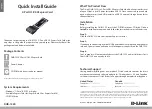
µ
PD75512
46
Note: When using the oscillation circuit of the main system clock and subsystem clock, wire the portion
enclosed in dotted line in the figures as follows to avoid adverse influences on the wiring capacity:
•
Keep the wiring length as short as possible.
• Do not cross the wiring over the other signal lines. Do not route the wiring in the vicinity of lines
through which a high alternating current flows.
• Always keep the ground point of the capacitor of the oscillator circuit at the same potential as V
DD
.
Do not connect the power source pattern through which a high current flows.
• Do not extract signals from the oscillation circuit.
The amplification factor of the subsystem clock oscillation circuit is designed to be low to reduce the
current dissipation and therefore, the subsystem clock oscillation circuit is influenced by noise more
easily than the main system clock oscillation circuit. When using the subsystem clock, therefore,
exercise utmost care in wiring the circuit.
★
RECOMMENDED OSCILLATION CIRCUIT CONSTANTS
MAIN SYSTEM CLOCK: CERAMIC OSCILLATOR (T
a
= -40 to +85
°
C)
External Capacitor (pF)
Oscillation Voltage Range (V)
Manufacturer
Product
Remarks
C1
C2
MIN.
MAX.
Kyocera
KBR-1000H
100
100
KBR-2.0MS
47
47
2.7
6.0
KBR-4.0MS
33
33
Murata
CSA 2.00MG
CSA 4.00MGU
30
30
2.7
CSA 4.19MG093
CSA 4.91MGU
CSA 4.91MG
30
30
3.0
6.0
CST 2.00MG
CST 4.00MGU
Internally
Internally
2.7
CST 4.19MG093
provided
provided
CST 4.91MGU
CST 4.91MG
Internally
Internally
3.0
provided
provided
Toko
CRHF 3.00
27
27
3.0
6.0
CRHF 4.19
MAIN SYSTEM CLOCK: CRYSTAL OSCILLATOR (T
a
= -20 to +70
°
C)
External Capacitor (pF)
Oscillation Voltage Range (V)
Manufacturer
Product
Remarks
C1
C2
MIN.
MAX.
Kinseki
HC-49/U
27
27
2.7
6.0
















































